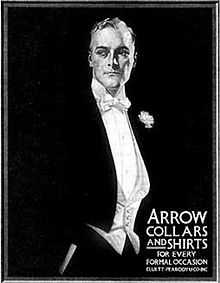The Arrow Collar Man


The Arrow Collar Man was the name given to the various male models who appeared in advertisements for shirts and detachable shirt collars manufactured by Cluett Peabody & Company of Troy, New York. The original campaign ran from 1905–31, though the company continued to refer to men in its ads and its consumers as "Arrow men" much later.
The Arrow Collar ads were a collaborative production of New York ad agency Calkins and Holden; Cluett, Peabody advertising director Charles Connolly; and commercial illustrator J. C. Leyendecker. One of Leyendecker's models was his live-in companion, a Canadian named Charles Beach.[1] Hundreds of printed advertisements were produced from 1907 to 1931 featuring the Arrow Collar Man. The fictional Arrow collar man became an icon, and by 1920 received fan mail. He inspired a Broadway musical Helen of Troy in 1923.
Attached collars
In the early 1920s, Cluett, Peabody & Co. began manufacturing their shirts with attached collars in response to consumer demand and became the most successful company in the U.S. at that time. Their sales increased to 4 million collars a week and Arrow shirts with attached collars were being exported to foreign ports such as Batavia (Jakarta) and the Belgian Congo. The Arrow Collar Man campaign ended in 1930, having been one of the most successful advertising campaigns in history.
References
- Lyrics from Irving Berlin song "Puttin' on the Ritz" include the line "High hats and Arrow collars..." in the second verse, 1946 version.
- Cole Porter referred to "Arrow Collars" in his song: "You're The Top" from the 1934 musical Anything Goes.
- ↑ Kamp, D. "Norman Rockwell's American Dream", Vanity Fair, no. 591, November 2009, p. 202.
Further reading
- Carole Turbin (November 2002). "Fashioning the American Man: The Arrow Collar Man, 1907–1931". Gender & History 14 (3): 470–491. doi:10.1111/1468-0424.00278.